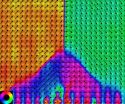(Press-News.org) WASHINGTON, March 15—In the latest twist on optical knots, New York University (NYU) physicists have discovered a new method to create extended and knotted optical traps in three dimensions. This method, which the NYU scientists describe in the Optical Society's (OSA) open-access journal Optics Express, produces "bright" knots, where the maximum of the light intensity traces out a knotted trajectory in space, for the first time allowing microscopic objects to be trapped along the path of the knot. The method may even, one day, help enable fusion energy as a practical power source, according to the NYU team.
Optical traps can be used to confine and manipulate small objects—ranging in size from a few nanometers to several hundred micrometers—in 3-D. They work because variations in the intensity of the light produce forces that push small objects toward bright regions. The trapping of small objects is widely used for a broad range of research applications in biophysics, condensed matter physics and medical diagnostics.
Ordinary optical traps use Gaussian laser beams that focus to a spot. The beams being used to create extended optical traps focus instead to curves, much like the bright patterns on the bottom of swimming pools. And these bright curves can be tied in knots.
Knotted traps are made by imprinting a computer-generated hologram on the wavefronts of an otherwise ordinary beam of light. NYU undergraduate student Elisabeth Shanblatt and NYU physicist David Grier, the authors of the Optics Express paper, use a "liquid-crystal spatial light modulator" to project their holograms. This is essentially the first cousin of a conventional LCD television screen. The spatial light modulator imprints a calculated pattern of phase shifts onto the light. When the modified beam is brought to a focus with a high-power lens, the region of maximum intensity takes the form of a 3-D curve. This curve can cross over and through itself to trace out a knot. Moreover, the same hologram can redirect the light's radiation pressure to have a component along the curve, so that the total optical force "threads the knot."
When Shanblatt and Grier began this investigation, they thought that creating knots would be a compelling and aesthetically pleasing demonstration of their method's power. Once the knots actually worked, they realized that there are very few—if any—other practical ways to create knotted force fields. Previously reported knotted vortex fields have intensity minima along the knot, rather than the intensity maxima, or "bright knots" that can be created using the computer-generated holograms.
Shanblatt was working on a project with Grier investigating these holographic optical traps, when they discovered a method for projecting holographic optical traps along arbitrary curves in 3-D, with amplitude and phase profiles independently specified (See Figure).
"The knotted optical force fields we created use intensity gradients to hold microscopic objects in place and phase gradients to thread them through the knot," says Shanblatt, describing their method. "These optical knots are a special type of a very general class of 3-D optical traps that can be created using holographic techniques."
Ordinary optical traps have current applications in biophysics, where they are used as surgical tools and to probe the elastic properties of biomolecules, and in condensed matter physics, where they assemble nanomaterials into 3-D functional structures and gauge the forces between microscopic objects. Extended optical traps are especially handy in moving small objects such as biological cells through microfluidic lab-on-a-chip devices. And they can be used to measure very small interactions among such objects, which is helpful for medical diagnostic tests.
Perhaps the most exciting and futuristic potential application the NYU team sees for their method is to create knotted current loops of charged particles in high-temperature plasmas. This is a long-sought-after goal for developing fusion energy as a practical power source.
How can their knots of light solve problems of fusion energy? Fusion reactors work by slamming light atomic nuclei into each other so hard that the nuclei fuse into heavier elements, releasing lots of energy. The best way to accomplish this, Grier says, is to heat the atoms to a high enough temperature so that they can overcome all of the barriers to fusion. At these temperatures, the atoms' electrons ionize and the gas becomes a plasma.
This is doubly good, notes Grier, because you can pass large electric currents through the plasma, therefore heating it still more. "You can also act on the currents with magnetic fields to contain the hot plasma, preventing it from destroying its physical container. These fusion plasmas are literally as hot as the core of the sun," he adds.
A problem occurs when currents flowing through plasma in a fusion reactor become unstable; this is similar to what occurs when the currents flowing through the plasma in a neon sign flicker. The currents thrash around, cool the plasma, damage the container, and generally prevent the process from generating useful energy.
"If the currents in a plasma are tied into a knot, the knot can eliminate most, if not all, of these instabilities because the magnetic field lines generated by the knotted current can't pass though each other," explains Grier.
Shanblatt and Grier believe that projecting a knotted optical force field into a plasma might prove to be a good way to initiate a knotted current loop. If so, the knotted current could then be ramped up by other conventional means. The result? Perhaps, a stable, high-temperature plasma capable of producing bountiful fusion energy.
INFORMATION:
Paper: "Extended and Knotted Optical Traps in Three Dimensions," Elisabeth R. Shanblatt, David G. Grier, Optics Express, Vol. 19, Issue 7, pp. 5833-5838, http://www.opticsinfobase.org/oe/abstract.cfm?uri=oe-19-7-5833
EDITOR'S NOTE: A high-resolution figure of the holographic trap is available upon request. Please contact Angela Stark, astark@osa.org.
About Optics Express
Optics Express reports on new developments in all fields of optical science and technology every two weeks. The journal provides rapid publication of original, peer-reviewed papers. It is published by the Optical Society and edited by C. Martijn de Sterke of the University of Sydney. Optics Express is an open-access journal and is available at no cost to readers online at http://www.OpticsInfoBase.org/OE.
About OSA
Uniting more than 106,000 professionals from 134 countries, the Optical Society (OSA) brings together the global optics community through its programs and initiatives. Since 1916 OSA has worked to advance the common interests of the field, providing educational resources to the scientists, engineers and business leaders who work in the field by promoting the science of light and the advanced technologies made possible by optics and photonics. OSA publications, events, technical groups and programs foster optics knowledge and scientific collaboration among all those with an interest in optics and photonics. For more information, visit http://www.osa.org.
Tying the knot with computer-generated holograms: Winding optical path moves matter
3-D optical trapping technique described in Optics Express holds potential for applications in energy, medicine
2011-03-16
ELSE PRESS RELEASES FROM THIS DATE:
Reliant Technology Offers IBM EXP810 Upgrade for Select IBM Storage Systems
2011-03-16
Reliant Technology, an EMC and IBM storage supplier, is proud to offer the IBM EXP810 storage upgrades for the IBM DS4000 series, including the IBM DS4800, the IBM DS4700, IBM FastT storage, the IBM DS4500, the IBM DS4300 and DS5020 storage systems, giving customers an affordable option for growth. Reliant Technology offers quality refurbished storage and SAN Hardware from IBM, EMC, NetApp Brocade, Data Domain, and HDS.
The IBM EXP810, otherwise known as an IBM expansion shelf or disk tray, is a 16 slot disk enclosure that allows IBM storage controllers to be upgraded ...
Finding of long-sought drug target structure may expedite drug discovery
2011-03-16
The researchers are from the National Institutes of Health, collaborating with labs at The Scripps Research Institute and the University of California, San Diego. The finding is published in the March 10 edition of Science Express.
"This is an important step forward — it was impossible until recently to know how this type of receptor is switched on by chemical signals like a tiny machine," said Dr. Kenneth A. Jacobson, chief of the Laboratory of Bioorganic Chemistry in NIH's National Institute of Diabetes and Digestive and Kidney Diseases (NIDDK) and an author on the ...
Corporate Colocation Inc. Completes Examination in Conformity with Statement on Auditing Standards No. 70 (SAS 70), Service Organizations
2011-03-16
The exhaustive audit covered the period September 1, 2010 through February 28, 2011 and was performed by an independent accounting and auditing firm.
Completion of the SAS 70 Type II examination indicates that Corporate Colocation Inc. processes, procedures and controls have been formally evaluated and tested by an independent accounting and auditing firm. The examination included the company's controls related to: Physical Security, Environmental Security and Network Monitoring.
SAS 70 is designated by the U.S. Securities and Exchange Commission (SEC) as an acceptable ...
New laser technique opens doors for drug discovery
2011-03-16
A new laser technique has demonstrated that it can measure the interactions between proteins tangled in a cell's membrane and a variety of other biological molecules. These extremely difficult measurements can aid the process of drug discovery.
Scientists estimate that about 30 percent of the 7,000 proteins in a human cell reside in the cell's membrane and that these membrane proteins initiate 60 to 70 percent of the signals that control the operation of the cell's molecular machinery. As a result, about half of the drugs currently on the market target membrane proteins.
Despite ...
Fundamental discovery could lead to better memory chips
2011-03-16
ANN ARBOR, Mich.---Engineering researchers at the University of Michigan have found a way to improve the performance of ferroelectric materials, which have the potential to make memory devices with more storage capacity than magnetic hard drives and faster write speed and longer lifetimes than flash memory.
In ferroelectric memory the direction of molecules' electrical polarization serves as a 0 or a 1 bit. An electric field is used to flip the polarization, which is how data is stored.
With his colleagues at U-M and collaborators from Cornell University, Penn State ...
Chasing the pot of gold: WSU researchers study gambling subtypes and treatment outcomes
2011-03-16
DETROIT — Approximately two million adults in the United States meet criteria for pathological gambling, and another four to six million are considered problem gamblers, according to the National Council on Problem Gambling. A study by researchers at Wayne State University reveals that gambling addiction treatment is not one-size-fits-all, but it is difficult to predict which style of treatment is best for the various forms of gambling addiction.
According to David M. Ledgerwood, Ph.D., assistant professor of psychiatry and behavioral neurosciences at Wayne State University, ...
US health care reforms should use model developed by Queen's University professor
2011-03-16
A model of health care developed by a Queen's University doctor should be studied and copied as a way to reform health care in the U.S.
The U.S. is facing a problem of adding 40 million people to its health care system if President Obama's health care reforms are passed and Ontario's Family Health Team Model (FHT) could help ease the burden.
"What we are saying is that Ontario's FHT model is a very effective and efficient way of providing health care," says Walter Rosser, professor in the Department of Family Medicine. "It should be part of the solution for health system ...
Metro-North Railroad Purchases Smart Software's SmartForecasts to Improve Service, Reduce Inventory, and Save Money
2011-03-16
Smart Software, Inc., provider of industry-leading demand forecasting, planning, and inventory optimization solutions, today announced that Metro-North Railroad (MNR) has purchased Smart's flagship product, SmartForecasts, as part of a company-wide service improvement and inventory reduction program. MNR, the nation's second largest commuter railroad, serves 275,000 passengers each weekday in the New York City metropolitan area, operating 1,193 engines and rail cars over 765 miles of track. It will use SmartForecasts to reduce inventory stocking levels for its 40,000 active ...
Malaria drug slows pancreatic cancer growth in mouse models
2011-03-16
BOSTON--Dana-Farber Cancer Institute scientists report they have shrunk or slowed the growth of notoriously resistant pancreatic tumors in mice, using a drug routinely prescribed for malaria and rheumatoid arthritis.
The pre-clinical results, which will appear in the April issue of the journal Genes & Development and is currently published on its web site, have already prompted the opening of a small clinical trial in patients with advanced pancreatic cancer, one of the deadliest and hardest-to-treat forms of cancer, said the investigators, led by Alec Kimmelman, MD, ...
Unprecedented view of protein folding may help develop brain disease therapies
2011-03-16
Misfold an origami swan and the worst that happens is you wind up with an ugly paper duckling. Misfold one of the vital proteins in your body – each of which must be folded in a particular way to perform its function – and the result can be a debilitating neurodegenerative disease such as Alzheimer's or Huntington's.
There are no cures for such brain-wasting diseases, but now Stanford researchers have taken an important step that may one day aid in developing therapies for them. They have literally popped the lid off one of the microscopic chambers in which many of life's ...
LAST 30 PRESS RELEASES:
Low daily alcohol intake linked to 50% heightened mouth cancer risk in India
American Meteorological Society announces Rick Spinrad as 2026 President-Elect
Biomass-based carbon capture spotlighted in newly released global climate webinar recording
Illuminating invisible nano pollutants: advanced bioimaging tracks the full journey of emerging nanoscale contaminants in living systems
How does age affect recovery from spinal cord injury?
Novel AI tool offers prognosis for patients with head and neck cancer
Fathers’ microplastic exposure tied to their children’s metabolic problems
Research validates laboratory model for studying high-grade serous ovarian cancer
SIR 2026 delivers transformative breakthroughs in minimally invasive medicine to improve patient care
Stem Cell Reports most downloaded papers of 2025 highlight the breadth and impact of stem cell research
Oxford-led study estimates NHS spends around 3% of its primary and secondary care budget on the health impacts of heat and cold in England
A researcher’s long quest leads to a smart composite breakthrough
Urban wild bees act as “microbial sensors” of city health.
New study finds where you live affects recovery after a hip fracture
Forecasting the impact of fully automated vehicle adoption on US road traffic injuries
Alcohol-related hospitalizations from 2016 to 2022
Semaglutide and hospitalizations in patients with obesity and established cardiovascular disease
Researchers ‘listen in’ to embryo-mother interactions during implantation using a culture system replicating the womb lining
How changing your diet could help save the world
How to make AI truly scalable and reliable for real-time traffic assignment?
Beyond fragmented markets: A new framework for efficient and stable ride-pooling
Can shape priors make road perception more reliable for autonomous driving?
AI tracks nearly 100 years of aging research, revealing key trends and gaps
Innovative techniques enable Italy’s first imaging of individual trapped atoms
KIER successfully develops Korea-made “calibration thermoelectric module” for measuring thermoelectric device performance
Diversifying US Midwest farming for stability and resilience
Emphasizing immigrants’ deservingness shifts attitudes
Japanese eels, climate change, and river temperature
Pusan National University researchers discover faster, smarter heat treatment for lightweight magnesium metals
China’s 2024 Gastroenterology Report: marked progress in endoscopy quality and disease management
[Press-News.org] Tying the knot with computer-generated holograms: Winding optical path moves matter3-D optical trapping technique described in Optics Express holds potential for applications in energy, medicine







